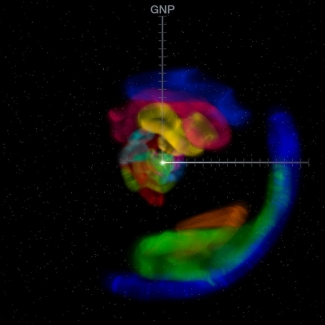In 2008, Fellow Jeff Linsky and his colleague Seth Redfield of Wesleyan University used spectral information gathered by the Hubble Space Telescope to figure out that the solar system is surrounded by 15 nearby clouds of warm gas, all within 50 light years of the Sun. In 2014, Cécile Gry of Aix-Marseille Université (France) and Edward Jenkins of Princeton University Observatory analyzed the same data, but came up with a much simpler picture of the local interstellar medium, or LISM. These researchers suggested that rather than comprising 15 different clouds, the LISM is made of a single continuous cloud that surrounds the Sun.
When the second model was proposed, the two groups of astrophysicists did what scientists do best. They began citing additional evidence supporting their respective models, which were both consistent with the same data set. One argument made by Gry and Jenkins was that if there are 15 separate clouds, then there should be holes among the clouds, but no such holes have been found. Linsky and Redfield countered with an analysis showing that the odds of finding even a single hole were much less than one-tenth of 1%.
For their part, Linsky and Redfield offered three reasons in support of their theory. First, they pointed out that the speed and direction of the flow of gas is different for each one of their 15 clouds. So, they asked Gry and Jenkins to propose a mechanism to explain how a single continuous cloud could exhibit so many changes in speed and direction. Second, many of the 15 clouds appear to be quite long and thin because they are shaped (as predicted) by strong magnetic fields near the Sun. Finally, the 15-cloud model explains why quasars twinkle at radio-wave frequencies. Twinkling results from the interaction of Earth’s changing position as it orbits around the Sun with the irregular shape of the local interstellar clouds found in the direction of twinkling quasars. Since only quasars in the lines of sight through cloud boundaries twinkle, individual LISM clouds must periodically lie in between the twinkling quasars and Earth.
However, a more quantitative test of the two models came in 2014. The Hubble Space Telescope obtained new, high-resolution spectra of stars shining through the LISM. When the researchers looked at the new data, Linsky and Redfield’s 15-cloud model was significantly better at predicting specific stellar spectral observations than the single-cloud model of Gry and Jenkins.
The new observations also underscored the idea that there are still many questions to be answered about the structure of the LISM. For instance, even though they are difficult to detect, there should be identifiable holes between 15 separate clouds. Linsky and Redfield’s theory would be even more strongly supported if such holes were discovered and characterized.
Another benefit would be that science’s understanding of our corner of the Universe would be enhanced. And, the better scientists understand the properties and evolution of the interstellar medium close to home, the better chance they have of understanding it across wide swaths of the Universe.––Julie Phillips



 The Physics Frontiers Centers (PFC) program supports university-based centers and institutes where the collective efforts of a larger group of individuals can enable transformational advances in the most promising research areas. The program is designed to foster major breakthroughs at the intellectual frontiers of physics by providing needed resources such as combinations of talents, skills, disciplines, and/or specialized infrastructure, not usually available to individual investigators or small groups, in an environment in which the collective efforts of the larger group can be shown to be seminal to promoting significant progress in the science and the education of students. PFCs also include creative, substantive activities aimed at enhancing education, broadening participation of traditionally underrepresented groups, and outreach to the scientific community and general public.
The Physics Frontiers Centers (PFC) program supports university-based centers and institutes where the collective efforts of a larger group of individuals can enable transformational advances in the most promising research areas. The program is designed to foster major breakthroughs at the intellectual frontiers of physics by providing needed resources such as combinations of talents, skills, disciplines, and/or specialized infrastructure, not usually available to individual investigators or small groups, in an environment in which the collective efforts of the larger group can be shown to be seminal to promoting significant progress in the science and the education of students. PFCs also include creative, substantive activities aimed at enhancing education, broadening participation of traditionally underrepresented groups, and outreach to the scientific community and general public.